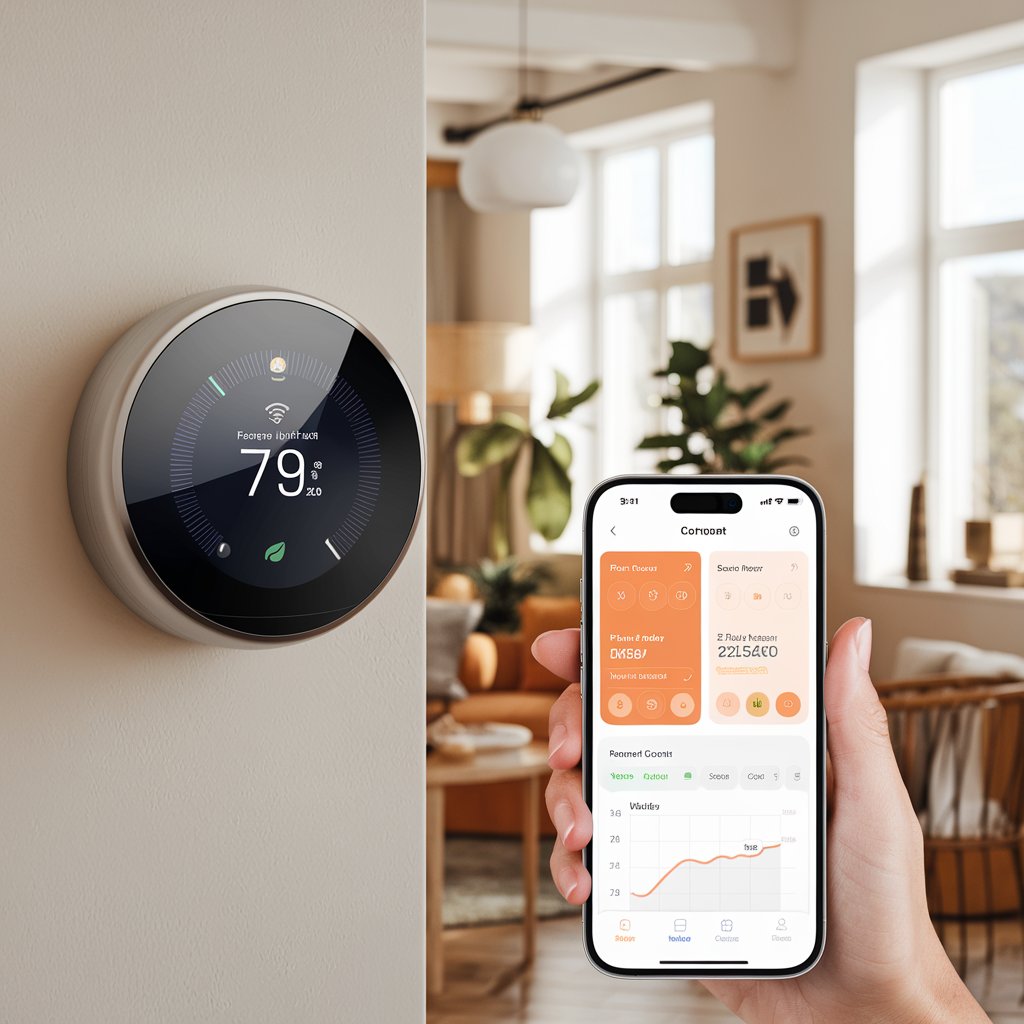Are you tired of high energy bills? Want to make your home smarter without spending too much money? A smart thermostat might be just what you need. In this guide, we’ll show you why buying a smart thermostat should be your first step into the world of smart home technology.
Contents
- 1 What is a Smart Thermostat?
- 2 The Money-Saving Benefits
- 3 Cost vs. Benefits Analysis
- 4 Top 5 Reasons to Choose a Smart Thermostat First
- 5 Real Energy Savings Data
- 6 Smart Features That Save Money
- 7 Health and Comfort Benefits
- 8 Easy Setup Process
- 9 Common Questions Answered
- 10 Seasonal Benefits
- 11 Making the Decision
- 12 Final Thoughts
What is a Smart Thermostat?
A smart thermostat is like a normal thermostat but with a brain. It connects to your WiFi and lets you control your home’s temperature from your phone. But that’s just the start – these devices can learn your schedule, adjust temperatures automatically, and help you save money.
How is it Different from a Regular Thermostat?
Let’s compare the key differences:
| Feature | Regular Thermostat | Smart Thermostat |
|---|---|---|
| Temperature Control | Manual only | Manual + Automatic |
| Programming | Basic or none | Advanced + Learning |
| Remote Access | No | Yes, from anywhere |
| Energy Reports | No | Detailed monthly reports |
| Weather Adaptation | No | Automatic adjustments |
| Smartphone Control | No | Yes |
| Maintenance Alerts | No | Yes |
| Voice Control | No | Yes |
The Money-Saving Benefits
Let’s talk about what matters most – saving money. According to Energy Star, a smart thermostat can save you about $100-$200 every year on heating and cooling bills. Here’s a breakdown of potential savings:
| Time Period | Average Savings |
|---|---|
| Monthly | $8-$17 |
| Yearly | $100-$200 |
| 5 Years | $500-$1,000 |
| 10 Years | $1,000-$2,000 |
Hidden Savings You Might Not Know About
Smart thermostats can save you money in ways you might not expect:
- Lower Maintenance Costs
- Timely filter change reminders
- Early warning of system problems
- Prevention of major breakdowns
- Extended System Life
- Better temperature management
- Reduced system strain
- More efficient operation
- Time Savings
- No manual adjustments needed
- Remote control convenience
- Automatic seasonal changes
Cost vs. Benefits Analysis
Most smart thermostats cost between $100-$300. Here’s how the numbers work out:
- Average cost of a smart thermostat: $200
- Installation cost (if professional): $100-$150
- First-year total cost: $300-$350
- First-year savings: $100-$200
- Time to break even: 1.5-2 years
Available Rebates and Incentives
Many organizations offer money back when you buy a smart thermostat:
- Energy companies: $25-$100 rebate
- Government programs: Up to $100 tax credit
- Manufacturer rebates: $15-$50 cash back
- Special installation deals: $50-$100 off
Top 5 Reasons to Choose a Smart Thermostat First
- Easy to Install
- Most people can install it themselves in under 1 hour
- Clear instructions included
- Many brands offer video guides
- Compatible with most heating/cooling systems
- 24/7 support available
- Simple to Use
- User-friendly apps
- Clear touch screens
- Voice control with Alexa or Google Assistant
- Automatic updates
- Intuitive scheduling
- Saves Energy Without Thinking
- Learns your schedule automatically
- Turns off when you’re away
- Adjusts based on weather
- Shows energy usage in real-time
- Optimizes for efficiency
- Quick Return on Investment
- Pays for itself in about 2 years
- Longer lifespan than regular thermostats (5-10 years)
- Often eligible for energy company rebates
- Increases home value
- Reduces maintenance costs
- Makes Life More Comfortable
- Warms up house before you wake up
- Cools down before you come home
- Maintains perfect temperature all day
- Warns you if something’s wrong with your system
- Manages humidity levels
Real Energy Savings Data
Here’s what actual users report saving with smart thermostats:
| Season | Average Energy Reduction |
|---|---|
| Summer | 15-23% on cooling |
| Winter | 10-12% on heating |
| Spring/Fall | 5-10% on both |
Success Stories from Real Users
“I saved $32 on my first month’s bill just by letting the thermostat learn my schedule.” – Sarah from Texas
“Our winter heating bills went down by 15% after installing a smart thermostat.” – Mike from Minnesota
“The app alerts helped us catch a problem with our AC before it became serious.” – Lisa from Florida
Smart Features That Save Money
Smart thermostats come with special features that help save money:
Basic Features
- Learning Mode: Remembers your temperature preferences
- Occupancy Sensing: Knows when you’re home or away
- Weather Monitoring: Adjusts based on outside temperature
- Energy Reports: Shows where you can save more
- Maintenance Alerts: Tells you when to change filters
Advanced Features
- Multi-Room Control: Different temperatures in different rooms
- Smart Home Integration: Works with other smart devices
- Geofencing: Adjusts based on your phone’s location
- Time-of-Use Optimization: Saves money during peak rate hours
- Vacation Mode: Special settings while you’re away
Health and Comfort Benefits
Besides saving money, smart thermostats can make your home healthier:
Temperature Management
- Keep temperature steady for better sleep
- Reduce humidity to prevent mold
- Filter reminders for cleaner air
- Temperature alerts for pets when you’re away
Air Quality Benefits
- Monitors indoor air quality
- Tracks humidity levels
- Suggests ventilation times
- Integrates with air purifiers
Easy Setup Process
Getting started is simple:
- Check if your system is compatible (most are)
- Buy the thermostat (many stores offer installation)
- Install it yourself or hire a pro
- Connect to WiFi
- Download the app
- Start saving money
What You Need Before Installation
- WiFi network name and password
- Smartphone or tablet
- Basic tools (screwdriver)
- 30-60 minutes of time
- Your existing thermostat wiring information
Common Questions Answered
Q: Will it work with my heating system?
A: Most smart thermostats work with about 95% of home heating and cooling systems.
Q: What if my WiFi goes out?
A: The thermostat keeps working like a regular one, just without smart features until WiFi returns.
Q: Do I need to be tech-savvy?
A: No! If you can use a smartphone, you can use a smart thermostat.
Q: Can I install it myself?
A: Yes, most people can install it in under an hour with basic tools.
Q: What happens if I lose power?
A: Smart thermostats have battery backup and keep their settings.
Seasonal Benefits
Summer Benefits
- Pre-cool home before peak hours
- Reduce AC use when no one’s home
- Monitor humidity levels
- Save on cooling costs
Winter Benefits
- Warm up house before waking
- Prevent pipe freezing
- Reduce heating in empty rooms
- Track heating efficiency
Spring and Fall
- Natural cooling schedules
- Automatic mode switching
- Allergy season air quality monitoring
- Energy-efficient temperature ranges
Making the Decision
When choosing your first smart home device, a smart thermostat makes sense because:
- It saves money right away
- It’s easy to install and use
- You don’t need other smart devices
- It works automatically once set up
- The benefits start immediately
What to Look for When Buying
- Compatibility with your HVAC system
- Available rebates in your area
- Warranty length
- Customer support quality
- User reviews and ratings
Final Thoughts
A smart thermostat is a perfect first step into making your home smarter. It’s not too expensive, saves money quickly, and makes your home more comfortable. With energy prices going up, it’s a smart choice that pays for itself faster than most home improvements.
Next Steps to Take
- Check your current energy bills
- Research compatible models
- Look for local rebates
- Choose installation method
- Plan the best time to install
Remember to:
- Check for rebates from your energy company
- Compare different brands and features
- Read user reviews
- Consider professional installation if you’re not comfortable doing it yourself
- Keep your installation manual and warranty information
Start your smart home journey with a device that pays you back – a smart thermostat is the perfect choice for your first smart home investment.



